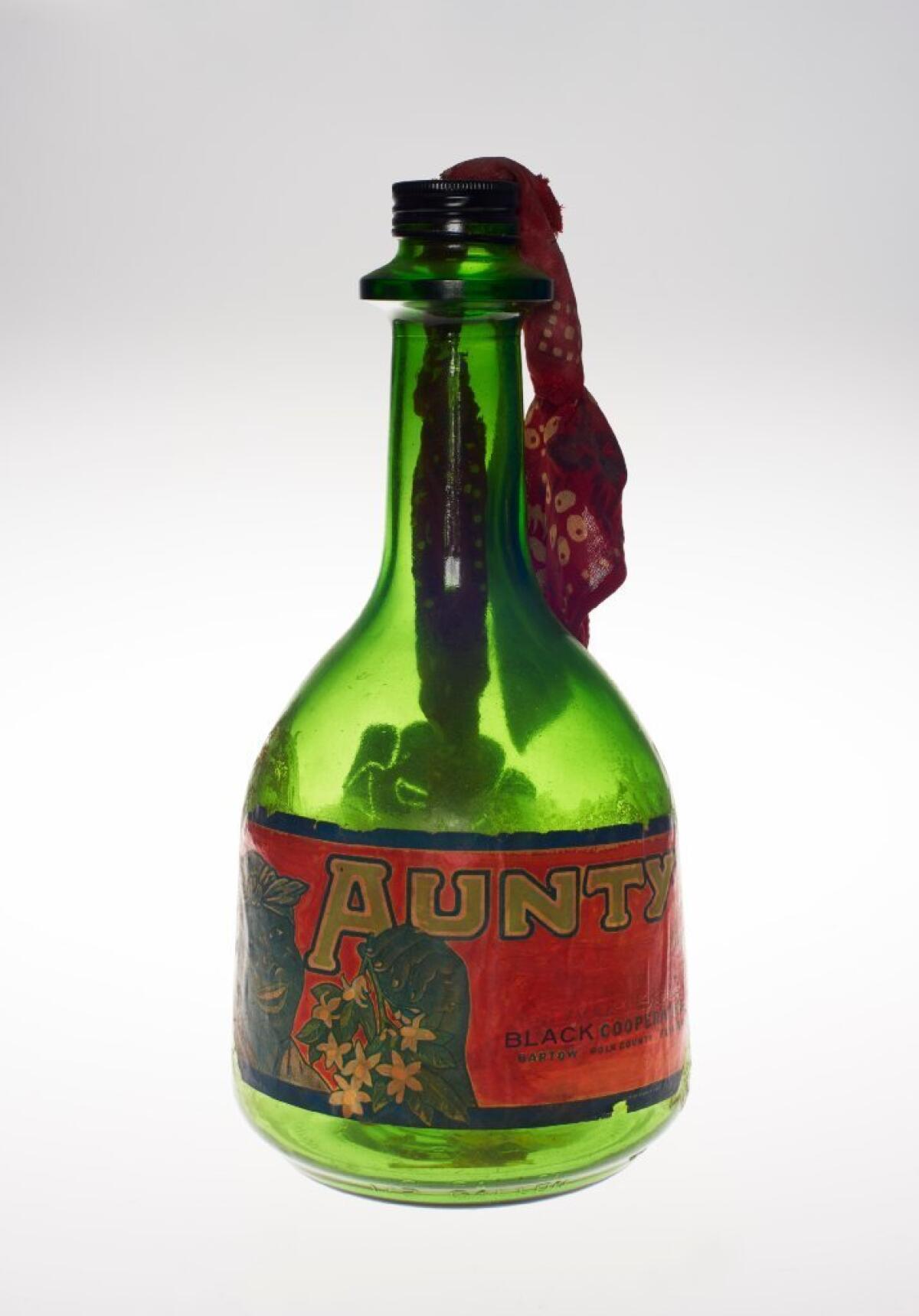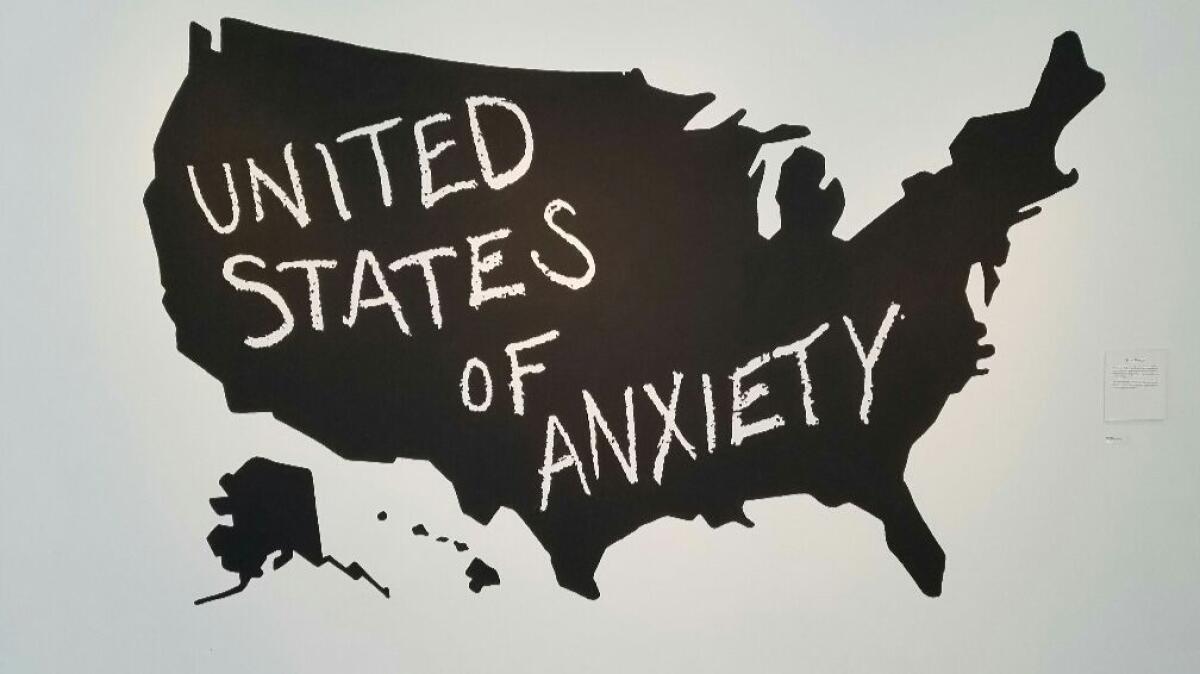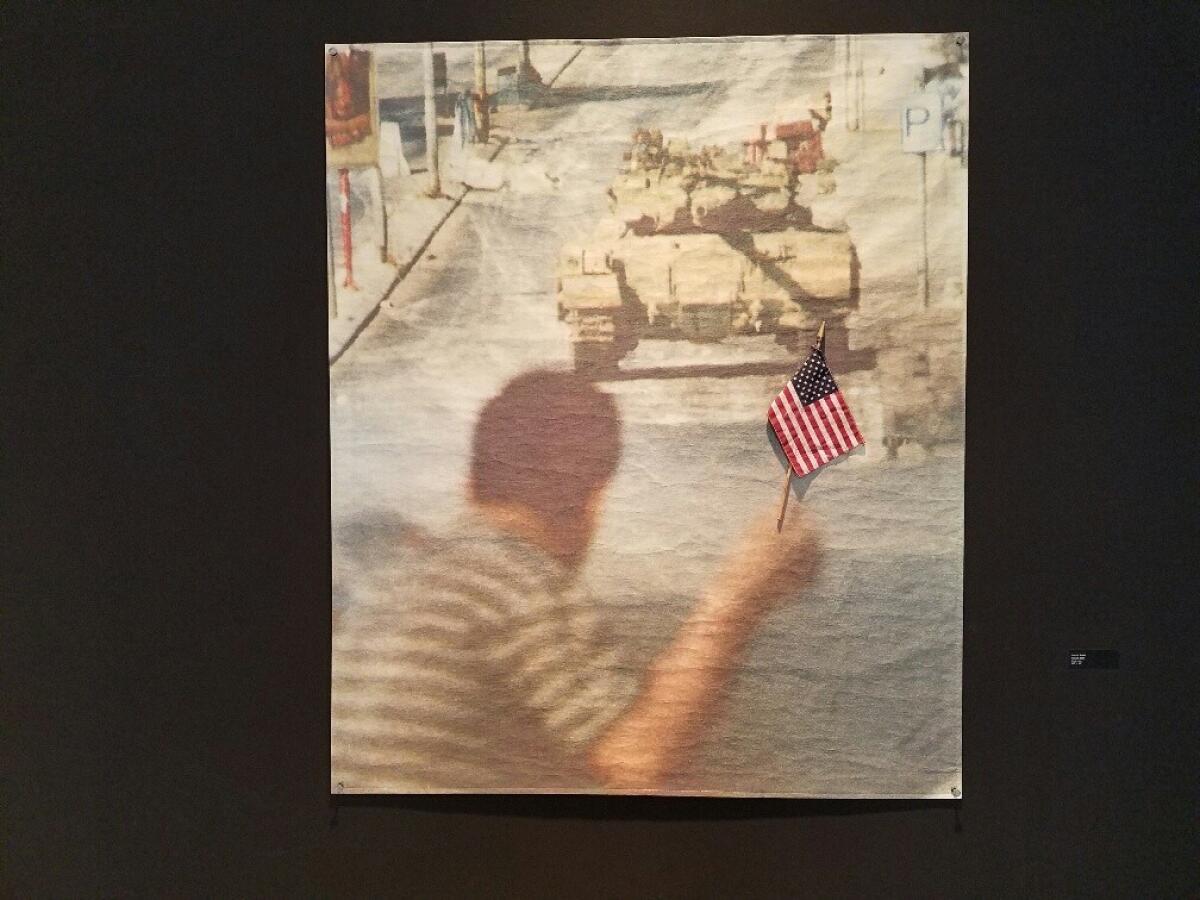Review: In these two art shows, the political is personal for our post-Women’s March country
- Share via
The most decisive day of 2017 came fast.
On Jan. 21, 5 million people flooded into streets around the world to demonstrate. The events came one day after the inauguration of a U.S. president who brazenly exploited racial animus, misogyny and xenophobia, all while stashing corporatist ambitions under the rug, in a discordant election campaign that saw him lose the popular vote by a substantial margin.
The Women’s March was a riveting display of coming resistance rooted in the nonviolent creed of the civil rights movement and led by an array of women. The anonymity of numbers recorded in the nation’s voting booths was transformed into an astonishing flesh-and-blood performance as the political became personal. That momentous context lends vibrancy to a pair of museum exhibitions, both winding up their runs as the anniversary of the landmark event approaches.
At Glendale’s Brand Library and Art Center, “One Year: The Art of Politics in Los Angeles” (through Jan. 12) is a thoughtful group exhibition of past and current work by 20 diverse artists that resonates against today’s troubled political climate. Multi-generational, it includes some artists who emerged in the 1970s, others still finding their voices in the present and still others who matured in between. Continuity in art’s politically engaged subject matter from one generation to the next is the central theme.
At the California African American Museum in Exposition Park, a more pointed history takes center stage. “We Wanted a Revolution: Black Radical Women, 1965-85” (through Jan. 14) assembles work by 40 artists — 39 women and one man, Jeff Donaldson (1932-2004), an Arkansas-born artist in Chicago who was instrumental in shaping the Black Arts Movement of the 1960s.
Donaldson’s 1969 painting on paper “Wives of Shango” shows a trio of rifle-toting Nigerian women, their bodies crisscrossed with bandoleers. The lithe beauty pageant typical of the Three Graces in European art gets remade into something fierce, confrontational and contemporary.
By example, the unexpected inclusion of a single male artist in a show of art by women makes a subtle if salient point: Tokenism was a significant issue in the era’s second-wave feminist movement. As a social justice initiative, feminism was largely white and middle-class; it did not always have room for the distinctive needs of women of color or the working poor.
Performance art, graphics and camera work (still and video) are abundant in the show, as in the well-known image-and-text works of such artists as Lorna Simpson and Carrie Mae Weems. Simpson juxtaposes sequences of photographs with text below, while Weems also tells visual/verbal stories, often of domestic life, picture-book style.
Yet these artists’ pictorial and written formats don’t always fit seamlessly together, as pairings of image and text typically do in popular media. There, the two reinforce each other. But Simpson’s text may or may not describe a nearby picture, while a Weems image might not appear to illustrate what you are reading.
Intentionally slipping and sliding, the frictional juxtapositions open up possibilities for unexpected meaning. Simpson and Weems use different techniques, but both pull apart and bust up media-driven stereotypes and clichés.
Howardena Pindell dives right into them. She was 21 when the Civil Rights Act passed in 1964. Her pivotal video, “Free, White and 21,” made 16 years later, is a series of confessional vignettes about racist indignities, large and small, that she suffered from her Philadelphia childhood onward.
Each scene is followed by Pindell enacting the role of a blond woman in whiteface, spitting out further humiliations. “Why so ungrateful, after all we’ve done for you?”
The sting leaps across decades, landing squarely in 2017: We live during a time when most white women voted for a race-baiting presidential candidate and, in Alabama, cast their ballots — by a margin of 63 to 34 — for Senate candidate Roy Moore. Alabama exit polls showed that African American voters, especially women, kept a man accused of being a racist and a child molester from going to Washington.



The intersection of race and gender likewise ignites the show’s most remarkable object — “The Liberation of Aunt Jemima: Cocktail,” a recently rediscovered 1973 assemblage by Betye Saar. A green glass wine jug sports a homemade Aunt Jemima label on one side and, on the other, a black power fist.
Stuffed inside the bottle is a red-and-white kerchief of the sort often worn in depictions of the jovial Jemima “mammy” from a commercial trademark that dates to the dawn of Jim Crow, before the turn of the 20th century. The woman’s scarf is the literal fuse of a potentially explosive Molotov cocktail. Saar’s sculpture is the embodiment of an African American woman declaring, “Enough!”
As a technique, assembling found objects didn’t carry the restrictive weight of centuries of tradition for sculpture, which had always been carved, cast or welded. A similar sense of freedom obtained for camera work, an image medium that historically took a back seat to painting. Assemblage and camera work also brought into the cultural mix elements of daily life that were long omitted from art.
Abstract art bears a more indirect relationship to social and political realities. In the show it stands as a plain example of the freedom to explore whatever an artist chooses. The long, thin, arcing lines of color against contrasting monochrome fields in Virginia Jaramillo’s crisp abstract paintings, which derive from the hard-edge precedent of such L.A. artists of the 1950s and ’60s as Lorser Feitelson and June Harwood, fit that bill.
If the exhibition has a weakness, it is a bias toward locating the post-1965 story of radical black women artists almost exclusively in Manhattan. (The traveling show was organized by the Brooklyn Museum.) It opens with the formation of Spiral, a ’60s New York black artists’ collective with a single female participant; proceeds to the pivotal 1971 Brooklyn exhibition “Where We At,” which partly grew out of frustrations with the general exclusion of women from groups like Spiral; and continues on to “bands of sisters,” including the participation of black women in the all-woman A.I.R. Gallery, Heresies Collective and Just Above Midtown gallery, all in New York.
Not present, to cite one surprising example, is Gallery 32, the important, largely undocumented Los Angeles space founded a few blocks from MacArthur Park in 1968 by artist Suzanne Jackson. Gallery 32 was an essential platform for the city’s black artists — women, including Saar, but also David Hammons, Timothy Washington and more.
Jackson’s own estimable paintings — liquid acrylic washes on canvas in which figures and landscapes grow from one another in dreamlike visions — are also disappointingly absent. The omission made me wonder what else in American avant-garde art produced beyond New York is not here.
At the Brand, generational continuity with subject matter that has a political edge is the looser, more generalized theme. Organized by artists Joey Forsyte, Lawrence Gipe and Alex Kritselis, whose work is also included, it takes the defensible position that on some level all art is political.
Politics is simply the ways and means by which we organize our social lives together. Art always embodies or reflects it, only sometimes directly engaging in issue-oriented subjects.



Forsyte’s “A Band of Voters” is an installation as rallying cry in which visitors are offered ways to participate in getting out the vote. By contrast, “United States of Anxiety,” a black-and-white 1995 wall mural by Scott Grieger at the show’s entrance, is effectively a sign — a black map blaring its title overwritten in jangling white — that makes art’s social reality clear.
Constance Mallinson’s big painting “Mountain” shows a dumpster’s worth of acutely depicted holiday trash, from birthday party balloons to Halloween knickknacks, that adds up to a groggy, morning-after celebration of waste and loss. Gipe’s monumental pair of two charcoal drawings abuts a lone protester hurling a stone with a bomber from the Cold War era lifting off in a cloud of exhaust; a latter-day David confronts a modern industrial Goliath.
More intimate are Keiko Fukazawa’s exquisitely crafted white porcelain guns overrun with white porcelain blossoms and Kohshin Finley’s five painterly black-and-white portraits.
Mao’s hundred flowers bloom in Fukazawa’s fragile confrontation with weapons of actual mass destruction: More than 33,000 people die in firearm-related deaths in the United States every year, according to an annual average compiled by the Centers for Disease Control.
In Finley’s work, roughly lifesize African American figures set against brushy gray backgrounds do not smile. Their expressions are instead variously determined, exhausted, saddened or defiant — which might have something to do with the appropriated costume of socially protective white paint emphatically brushed in patches across their black skin.
Pindell’s whiteface video at CAAM sets a precedent across time and space for Finley’s portraits.
For more than 40 years, Ben Sakoguchi has been painting mock orange-crate labels to scale, replacing their sun-kissed salesmanship of romanticized California life with harsher realities coursing through contemporary media. The 15 on view here include the bloody Sandy Hook massacre, last year’s insane Pizzagate conspiracy theory, today’s Orwellian flood of “alternative facts” and the endgame of global warming.
For all that, perhaps the most resonant work is Alexis Smith’s equivocal image of a male figure standing in front of an army tank, a hazy photo-collage printed on a loose banner. Evoking 1989’s Tiananmen Square protests without being fully descriptive of that famous event, the work is sent spinning by the astute addition of an actual American flag into the anonymous figure’s upraised hand.
“Patriot,” the 2004 work is titled. Whether the anonymous figure is standing up to tyranny or cheering it on is yours to decide. Made in the wake of America’s hapless if not criminal invasion of Iraq, Smith’s banner vibrates like a tuning fork as the new year breaks.

♦ ♦ ♦ ♦ ♦ ♦ ♦ ♦ ♦ ♦
‘We Wanted a Revolution: Black Radical Women, 1965-85’
Where: California African American Museum, 600 State St., Exposition Park, L.A.
When: Through Jan. 14
Info: (213) 744-2084, www.caamuseum.org
♦ ♦ ♦ ♦ ♦ ♦ ♦ ♦ ♦ ♦
‘One Year : The Art of Politics in Los Angeles’
Where: Brand Library and Art Center, 1601 W. Mountain St., Glendale
When: Through Jan. 12
Info: (818) 548-2051, www.brandlibrary.org
christopher.knight@latimes.com
Twitter: @KnightLAT
MORE ARTS READING:
Politics of 1960s and ’70s black radical female artists still speaks today
Trump’s border wall through the eyes of an architecture critic
A lifetime of paintings, lost in the Thomas fire
The biggest entertainment stories
Get our big stories about Hollywood, film, television, music, arts, culture and more right in your inbox as soon as they publish.
You may occasionally receive promotional content from the Los Angeles Times.








